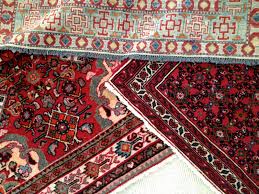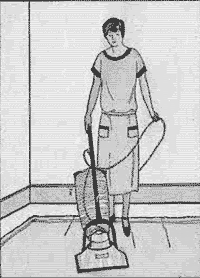Small Home Gazette, Winter 2011
Rug Cleaning 101
Whether they’re worth hundreds or thousands of dollars, your Persian and oriental rugs are an investment worth protecting. Regular vacuuming will go a long way toward extending the life and beauty of your rug. But once in awhile, your rug needs professional help.
After you’ve done your usual vacuuming, lift a corner of the rug and slap the back with your hand. If dirt comes out, it needs a professional cleaning. Or dampen a white towel and rub it across the surface of the rug. If the towel comes out dirty, your rug needs additional cleaning. Or closely inspect the rug’s fibers and look for dirt that has worked its way into the rug’s foundation. If any of these steps finds more dirt in the rug than you’d like, a professional cleaning is in your rug’s future.
The Professionals
 Before choosing a professional rug cleaner, become knowledgeable about your rug. Where and when was it made? Does it have natural or synthetic dyes? Is it handmade or machine-made? What type(s) of fibers does it contain? Knowing this information will help you ask informed questions and get you started on the right foot in your search for a professional cleaner.
Before choosing a professional rug cleaner, become knowledgeable about your rug. Where and when was it made? Does it have natural or synthetic dyes? Is it handmade or machine-made? What type(s) of fibers does it contain? Knowing this information will help you ask informed questions and get you started on the right foot in your search for a professional cleaner.
Your purchase paperwork might provide clues. Also, there are numerous websites that can help you learn more about your rug. Try searching on a simple question such as “What kind of oriental rug do I have?” Be aware that most of the results are from commercial rug sellers. Taking it to a local dealer for a quick ID is another option, but call ahead to make sure a knowledgeable person is available.
Second, do your homework on local companies. A recent survey by the Twin Cities office of Checkbook.org found at least a dozen independent and regional franchise cleaners in the area. Their extensive article is online, but their ratings of local firms are only available to subscribers. If you can give a cleaning company the basics about your rug, they should be able to give you a rough estimate of cost and turnaround.
Third, learn about the commercial cleaning process and the questions you should ask before handing over your precious rug. This article will help with this step.
“Hand washed”
 Most firms claim they hand wash rugs. In reality, hand-washing means people are using machines to speed the process. The exceptions are silk rugs and fragile, antique rugs, which should always be cleaned without machines.
Most firms claim they hand wash rugs. In reality, hand-washing means people are using machines to speed the process. The exceptions are silk rugs and fragile, antique rugs, which should always be cleaned without machines.
The first step in the professional cleaning process is to do an industrial-strength vacuuming of your rug and possibly blasting dirt and dust out of it with compressed air.
Next they’ll inspect the rug for damaged areas or stains. Be sure to tell them about problem areas that you know about.
Next comes a high pressure soaking with tepid water and a mild detergent. Workers then shampoo the rug with a scrubbing machine—similar to a carpet shampooer that mixes water and carpet shampoo through a rotating, soft nylon brush. This is intended to loosen the dirt and grime that has worked its way deep into the rug’s pile.
Then the rug is rinsed with high-pressure water. This step is critical to removing the dirt loosened in the shampooing process, as well as washing out the shampoo itself, which, if left in the rug, will leave a sticky residue that will attract new dirt and grime.
Some companies will then groom the rug with a brush so that its fibers all lie in the same direction, giving all the colors in your rug an even appearance.
The final step is drying, which is important to protect your rug from mildew, discoloration or stretching out of its original shape. Most companies use some combination of wringers, high-power wet vacuums, or a heated drying room with industrial dehumidifiers. Smaller firms may simply spread the rug on the floor and use fans to blow warm air across the surface. Drying times will, of course, vary considerably.
Questions to ask
- Can you describe your hand-washing process? See how it compares to the process noted above. Some firms may skip the shampooing process. Others may put your rug through a large machine that automates the entire process.
- Will they do the work in their shop? Some companies subcontract their cleaning work to another company. You may have more control over the quality of the cleaning process if a company does its own work.
- Do the workers only clean rugs like yours or do they also perform in-home carpet cleaning? Experience and attention to the unique cleaning needs of rugs is important.
- Can I get a detailed receipt or estimate? Paperwork that lists the type, size, special needs, and a description of your rug may be helpful to you if a problem or dispute arises.
Reality check

No amount of cleaning will restore the color of your rug if its been damaged by sunlight. Remember to regularly rotate your rug if a portion of it is in sunlight.
Some stains are especially difficult to remove, and the best that can be achieved is to make it less obvious.
If your rug is made of silk, is extremely delicate, or extremely valuable, it should be handled much differently than the process described above in the “Hand-Washed” section. Ask the company to explain their process in detail, as well as their experience and expertise in cleaning rugs similar to yours.
If you know or believe your rug is extremely valuable, have it appraised before cleaning so you can be fairly compensated by the firm or your homeowner’s insurance if the worst happens. This also will be handy documentation if the firm loses track of your rug.
Do-It-Yourself
Here are some basic steps you can take to extend the life of your Persian or oriental rug between professional cleanings.
Avoid putting your rug in a location that receives direct sunlight. If that isn’t possible, remember to rotate the rug frequently—as often as monthly if the sunlight is intense. The sun will fade your rug’s color, especially if natural dyes were used in the rug. Rotating the rug will spread the damage around, keeping the rug’s appearance as “even” as possible.
 Another reason to rotate your rug is to alter the wear pattern. This is especially true if the rug lies in a natural pathway.
Another reason to rotate your rug is to alter the wear pattern. This is especially true if the rug lies in a natural pathway.
Save your vacuum’s beater bar for the backside of the rug. Consider doing this first—flip the rug over (face down) and vacuum it with the beater bar. Do not use the beater bar on the fringe, as it will get tangled in the machine. Roll up the rug face side out and vacuum the dirt and dust that you’ve shaken loose onto the floor. Then roll out the rug face-up, and vacuum with the suction hose. Pull the wand in one direction with the grain rather than in a back-and-forth, scrubbing motion. Frequent vacuuming will remove dirt and dust before it works its way into the foundation of your rug.
Clean all spills immediately. First, absorb the spill with paper towels by gently daubing it from the edge of the spill toward the center to keep it from spreading. Place more paper towels under the stained area to stop further damage to the backing.









 by Martin Moen
by Martin Moen

